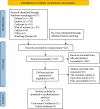Risk factors for delayed colorectal postpolypectomy bleeding: a meta-analysis
- PMID: 38745130
- PMCID: PMC11092041
- DOI: 10.1186/s12876-024-03251-6
Risk factors for delayed colorectal postpolypectomy bleeding: a meta-analysis
Abstract
Background: To systematically analyze risk factors for delayed postpolypectomy bleeding (DPPB) in colorectum.
Methods: We searched seven large databases from inception to July 2022 to identify studies that investigated risk factors for DPPB. The effect sizes were expressed by relative risk (RR) and 95% confidence interval (95% CI). The heterogeneity was analyzed by calculating I2 values and performing sensitivity analyses.
Results: A total of 15 articles involving 24,074 subjects were included in the study. The incidence of DPPB was found to be 0.02% (95% CI, 0.01-0.03), with an I2 value of 98%. Our analysis revealed that male sex (RR = 1.64), history of hypertension (RR = 1.54), anticoagulation (RR = 4.04), polyp size (RR = 1.19), polyp size ≥ 10 mm (RR = 2.43), polyp size > 10 mm (RR = 3.83), polyps located in the right semicolon (RR = 2.48) and endoscopic mucosal resection (RR = 2.99) were risk factors for DPPB.
Conclusions: Male sex, hypertension, anticoagulation, polyp size, polyp size ≥ 10 mm, polyps located in the right semicolon, and endoscopic mucosal resection were the risk factors for DPPB. Based on our findings, we recommend that endoscopists should fully consider and implement effective intervention measures to minimize the risk of DPPB.
Keywords: Colorectal polyps; Meta-analysis; Postoperative bleeding; Risk factors.
© 2024. The Author(s).
Conflict of interest statement
The authors declare no competing interests.
Figures
References
-
- Cheng P, Bo Y, Fang J, Zhao S, Wang S, Li N, et al. Risk factors of delayed colonoscopic post-polypectomy bleeding. Chin J Dig Endoscopy. 2018;35(5):332–5.
Publication types
MeSH terms
LinkOut - more resources
Full Text Sources
Medical




